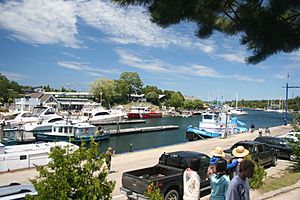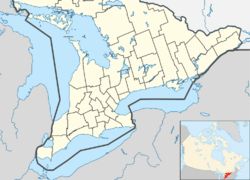Tobermory, Ontario facts for kids
Quick facts for kids
Tobermory
|
|
|---|---|
|
Community
|
|

Little Tub Harbour
|
|
| Etymology: Named after Tobermory in Scotland | |
| Country | |
| Province | |
| County | Bruce County |
| Municipality | Northern Bruce Peninsula |
| Time zone | UTC-5 (EST) |
| • Summer (DST) | UTC-4 (EDT) |
| Area code(s) | 519 |
Tobermory is a small community in Ontario, Canada. It sits at the very northern tip of the Bruce Peninsula. This area is the traditional home of the Saugeen Ojibway Nation. Their ancestors lived here as far back as 7,500 years ago.
Tobermory is part of the Northern Bruce Peninsula municipality. It is about 300 kilometers (186 miles) northwest of Toronto. The closest city is Owen Sound, which is 100 kilometers (62 miles) south. You can reach Tobermory by Highway 6.
The port was first called Collins Harbour. It was later renamed Tobermory, like the town on the Isle of Mull in Scotland.
Tobermory is known as the "freshwater SCUBA diving capital of the world." This is because many shipwrecks lie in the waters nearby. These wrecks are especially found in Fathom Five National Marine Park. Tobermory is a very popular place for vacations. The town is just north of the Bruce Peninsula National Park.
The MS Chi-Cheemaun ferry connects Tobermory to Manitoulin Island in Lake Huron. Tobermory is also the start point of the Bruce Trail. It has two harbors, called "Big Tub" and "Little Tub." Big Tub Harbour is Canada's largest natural freshwater harbor.
Tobermory is usually a bit colder than Toronto. Many businesses in town are open from May until the Thanksgiving long weekend in October. They close for the rest of the year.
Contents
Geography of Tobermory
The Government of Ontario has a special plaque in Tobermory. It explains the area's geography. The plaque talks about the "ESCARPMENT SUBMERGENCE." This means the shoreline here is the northern end of the Niagara Escarpment in southern Ontario.
The escarpment stretches for 465 miles from Niagara Falls. It was formed by erosion of layered rocks. These rocks were laid down in ancient seas over 400 million years ago. Parts of the escarpment form the islands between Tobermory and South Baymouth. The same ancient rocks also shape the land of Manitoulin Island.
In the past, people thought the land was not good for farming. In the 1870s and 1880s, the government sold land for farming. But many settlers found it hard to grow crops. Some gave up and left the land.
One important product from the Bruce Peninsula forests was hemlock tree bark. About 4,000 cords of hemlock bark were sent to places like Kitchener for tanneries. Tanneries use bark to make leather.
The first sawmill in Tobermory opened in 1881. Within 20 years, most of the valuable trees were gone. Fires then burned the land. By the 1920s, the forests were almost bare. This made many settlers leave. The population went down until the 1970s. Then, people started buying land for cottages, and the area became popular again.
Today, lumber is not a main industry in the Bruce Peninsula. But it was important for settling the region long ago.
Tobermory's Climate
Tobermory has a climate with four clear seasons. Summers are mild to warm. Winters are cold. Rain and snow happen throughout the year.
| Climate data for Tobermory (1951–1980) | |||||||||||||
|---|---|---|---|---|---|---|---|---|---|---|---|---|---|
| Month | Jan | Feb | Mar | Apr | May | Jun | Jul | Aug | Sep | Oct | Nov | Dec | Year |
| Record high °C (°F) | 11.7 (53.1) |
11.1 (52.0) |
20.0 (68.0) |
26.7 (80.1) |
30.0 (86.0) |
35.6 (96.1) |
36.1 (97.0) |
33.3 (91.9) |
33.3 (91.9) |
25.6 (78.1) |
18.9 (66.0) |
16.1 (61.0) |
36.1 (97.0) |
| Mean daily maximum °C (°F) | −2.8 (27.0) |
−2.8 (27.0) |
1.3 (34.3) |
8.2 (46.8) |
14.1 (57.4) |
19.4 (66.9) |
22.5 (72.5) |
22.2 (72.0) |
18.1 (64.6) |
12.5 (54.5) |
6.1 (43.0) |
0.1 (32.2) |
9.9 (49.8) |
| Daily mean °C (°F) | −6.3 (20.7) |
−6.9 (19.6) |
−2.7 (27.1) |
3.9 (39.0) |
9.0 (48.2) |
14.2 (57.6) |
17.9 (64.2) |
18.0 (64.4) |
14.1 (57.4) |
8.9 (48.0) |
3.2 (37.8) |
−3.1 (26.4) |
5.9 (42.6) |
| Mean daily minimum °C (°F) | −9.9 (14.2) |
−10.9 (12.4) |
−6.7 (19.9) |
−0.7 (30.7) |
3.9 (39.0) |
8.9 (48.0) |
13.2 (55.8) |
13.7 (56.7) |
10.0 (50.0) |
5.3 (41.5) |
0.3 (32.5) |
−6.3 (20.7) |
1.8 (35.2) |
| Record low °C (°F) | −30.6 (−23.1) |
−33.9 (−29.0) |
−27.2 (−17.0) |
−15.0 (5.0) |
−5.6 (21.9) |
−1.1 (30.0) |
1.7 (35.1) |
3.0 (37.4) |
−1.5 (29.3) |
−7.8 (18.0) |
−17.2 (1.0) |
−27.8 (−18.0) |
−33.9 (−29.0) |
| Average precipitation mm (inches) | 71.9 (2.83) |
46.9 (1.85) |
51.6 (2.03) |
66.3 (2.61) |
54.8 (2.16) |
69.1 (2.72) |
62.8 (2.47) |
73.8 (2.91) |
79.8 (3.14) |
70.5 (2.78) |
75.6 (2.98) |
85.4 (3.36) |
808.5 (31.83) |
| Average rainfall mm (inches) | 12.6 (0.50) |
14.0 (0.55) |
28.6 (1.13) |
66.1 (2.60) |
54.7 (2.15) |
69.1 (2.72) |
62.8 (2.47) |
74.1 (2.92) |
79.8 (3.14) |
70.0 (2.76) |
61.5 (2.42) |
36.6 (1.44) |
629.9 (24.80) |
| Average snowfall cm (inches) | 58.0 (22.8) |
33.0 (13.0) |
22.6 (8.9) |
2.7 (1.1) |
0.1 (0.0) |
0.0 (0.0) |
0.0 (0.0) |
0.0 (0.0) |
0.0 (0.0) |
0.4 (0.2) |
14.1 (5.6) |
49.9 (19.6) |
180.8 (71.2) |
| Average precipitation days (≥ 0.2 mm) | 10 | 8 | 7 | 7 | 7 | 8 | 6 | 7 | 9 | 9 | 9 | 12 | 99 |
| Average rainy days (≥ 0.2 mm) | 2 | 1 | 3 | 6 | 7 | 8 | 6 | 7 | 9 | 9 | 7 | 4 | 69 |
| Average snowy days (≥ 0.2 cm) | 9 | 7 | 4 | 1 | 0 | 0 | 0 | 0 | 0 | 0 | 2 | 8 | 31 |
| Source: Environment Canada | |||||||||||||
Nature and Wildlife in Tobermory
Tobermory is home to many different kinds of plants and animals. Old cedar trees grow along the cliff edges. Large, thick forests cover Tobermory and the Bruce Peninsula. Black bears and rare reptiles also live in the rocky areas and wetlands.
You might see black bears, raccoons, white-tailed deer, porcupines, and chipmunks. There are also many types of snakes. The Eastern Massasauga rattlesnake can be found here, but it is an endangered species.
The area has about 43 types of wild orchids. This is because of its many different habitats. To celebrate these flowers, Tobermory hosts an annual orchid festival in June. It includes guided tours and presentations.
One type of flower grows only in Big Tub harbor and nowhere else in the world.
In the early 1900s, after much logging, settlers started fishing. Fishermen began dropping nets in Tobermory's deep harbors, Big and Little Tub, in the late 1800s. But the fish numbers started to drop in the early 1920s. This was due to too much fishing and the arrival of the lamprey eel.
Fun Things to Do in Tobermory
Explore Fathom Five National Marine Park
Tobermory is right next to Fathom Five National Marine Park. This was Canada's first national marine conservation area. The park has 22 shipwrecks to explore. It also has several old lighthouses. You can take glass-bottom boat tours from Tobermory to see the shipwrecks.
Visit Lion's Head
Lion's Head is a cliff edge shaped like a lion's head. It has been a popular spot for tourists for many years. Sailors used it as a landmark in the past. It also offered shelter from the rough waters of Georgian Bay.
Enjoy the Bruce Trail
The Bruce Trail is a famous hiking path. It starts in Tobermory and goes all the way south to Niagara Falls. It offers amazing views from the cliff edges over the clear blue water. It is one of Canada's oldest and longest walking trails.
Getting Around Tobermory
The main road in Tobermory is Ontario Highway 6. This highway ends here because Georgian Bay interrupts it. The ferry, MS Chi-Cheemaun, connects the two parts of Highway 6 for part of the year.
Tobermory Airport is a small public airport. It is used for general aviation and is located south of the town.
Media in Tobermory
Local News
The local newspaper is called the Tobermory Press.
Radio Stations
- CHEE-FM 89.9 in Tobermory gives seasonal updates about the MS Chi-Cheemaun ferry.
- CBPS-FM 90.7 from Bruce Peninsula National Park shares tourism, park, and weather information.
- CFPS-FM from Port Elgin has a repeater at Tobermory on 91.9 FM.
- CHFN-FM 100.1 is a First Nations community radio station from Neyaashiinigmiing.
- You can also hear other radio stations from Owen Sound, Manitoulin Island, Sudbury, and even parts of Michigan and Central Ontario in Tobermory.




